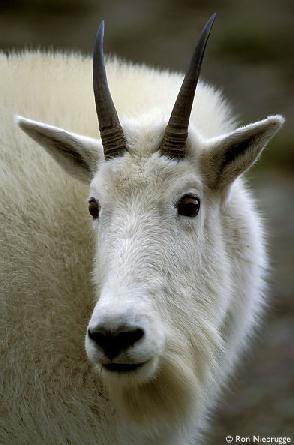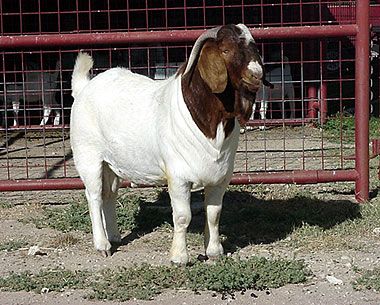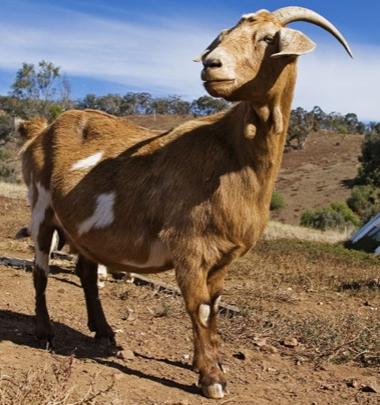Fried Goat ©2023. All Rights Reserved
EDUCATION
The domestic goat (Capra aegagrus hircus) is a subspecies of goat domesticated from the wild goat of southwest Asia and Eastern Europe. The goat is a member of the Bovidae family and is closely related to the sheep, both being in the goat antelope subfamily Caprinae.
Domestic goats are one of the oldest domesticated species. For thousands of years, goats have been used for their milk, meat, hair, and skins over much of the world.[1] In the last century they have also gained some popularity as pets.[2]
Female goats are referred to as does or nannies (or, less frequently, as mishas), intact males as bucks or billies; their offspring are kids. Castrated males are wethers. Goat meat from younger animals is called kid, and from older animals is sometimes called chevon, or in some areas mutton.
Etymology
The Modern English word "goat" comes from the Old English gat which meant "she-goat", and this in turn derived from Proto-Germanic *gaitaz (compare Old Norse and Dutch geit'(meaning' "goat"), German Geiß' ("she-goat") and Gothic gaits, ("goat")) ultimately from Proto-Indo-European *ghaidos meaning "young goat" but also "play" (compare Latin haedus meaning "kid"). The word for "male goat" in Old English was bucca (which survives as "buck", meaning certain male herbivores) until a shift to "he-goat" (and also "she-goat") occurred in the late 12th century. "Nanny goat" originated in the 18th century and "billy goat" in the 19th.
History
Goats seem to have been first domesticated roughly 10,000 years ago in the Zagros Mountains of Iran.[3] Ancient cultures and tribes began to keep them for easy access to milk, hair, meat, and skins. Domestic goats were generally kept in herds that wandered on hills or other grazing areas, often tended by goatherds who were frequently children or adolescents, similar to the more widely known shepherd. These methods of herding are still used today.
Historically, goat hide has been used for water and wine bottles in both traveling and transporting wine for sale. It has also been used to produce parchment, which was the most common material used for writing in Europe until the invention of the printing press.
Anatomy
Goats are ruminants. They have a four-chambered stomach consisting of the rumen, the reticulum, the omasum, and the abomasum.
Goats have horizontal slit-shaped pupils, an adaptation which increases peripheral depth perception.[4]. Because goats' irises are usually pale, the pupils are much more visible than in animals with horizontal pupils but very dark irises, such as sheep, cattle and most horses.
Some breeds of sheep and goats appear superficially similar, but goat tails are short and point up, whereas sheep tails hang down and are usually longer (though some are short, and some long ones are docked).
Reproduction
In some climates, goats are able to breed at any time of the year. In temperate climates and among the Swiss breeds, the breeding season commences as the day length shortens, and ends in early spring. Does of any breed come into heat every 21 days for 2 to 48 hours. A doe in heat typically flags her tail often, stays near the buck if one is present, becomes more vocal, and may also show a decrease in appetite and milk production for the duration of the heat.
Bucks (intact males) of Swiss and northern breeds come into rut in the fall as with the doe's heat cycles. Rut is characterized by a decrease in appetite and obsessive interest in the does.
In addition to natural mating, artificial insemination has gained popularity among goat breeders, as it allows easy access to a wide variety of bloodlines.
Gestation length is approximately 150 days. Twins are the usual result, with single and triplet births also common. Less frequent are litters of quadruplet, quintuplet, and even sextuplet kids. Birthing, known as kidding, generally occurs uneventfully. Right before kidding the doe will have a sunken area around the tail and hip. Also she will have heavy breathing, a worried look, become restless and show great display of affection for her keeper. The mother often eats the placenta, which gives her much needed nutrients, helps stanch her bleeding, and is believed by some[attribution needed] to reduce the lure of the birth scent for predators.
Freshening (coming into milk production) occurs at kidding. Milk production varies with the breed, age, quality, and diet of the doe; dairy goats generally produce between 660 to 1,800 L (1,500 and 4,000 lb) of milk per 305 day lactation. On average, a good quality dairy doe will give at least 6 lb (2.7 l) of milk per day while she is in milk, although a first time milker may produce less, or as much as 16 lb (7.3 l) or more of milk in exceptional cases. Meat, fiber, and pet breeds are not usually milked and simply produce enough for the kids until weaning.
Diet
Goats are reputed to be willing to eat almost anything. The digestive systems of a goat allow nearly any organic substance to be broken down and used as nutrients.
Contrary to this reputation, they are quite fastidious in their habits, preferring to browse on the tips of woody shrubs and trees, as well as the occasional broad leaved plant. However, it can fairly be said that goats will eat almost anything in the botanical world. Their plant diet is extremely varied and includes some species which are toxic or detrimental to cattle and sheep. This makes them valuable for controlling noxious weeds and clearing brush and undergrowth. They will seldom eat soiled food or contaminated water unless facing starvation. This is one of the reasons why goat rearing is most often free ranging since stall-fed goat rearing involves extensive upkeep and is seldom commercially viable.
Goats do not usually consume garbage, tin cans, or clothing, although they will occasionally eat items made primarily of plant material, which can include wood. They have an intensely inquisitive and intelligent nature: they will explore anything new or unfamiliar in their surroundings. They do so primarily with their prehensile upper lip and tongue. This is why they investigate items such as buttons, camera cases or clothing (and many other things besides) by nibbling at them, occasionally even eating them.
The digestive physiology of a very young kid (like the young of other ruminants) is essentially the same as that of a monogastric animal. Milk digestion begins in the abomasum, the milk having bypassed the rumen via closure of the reticular/esophageal groove during suckling. At birth the rumen is undeveloped, but as the kid begins to consume solid feed, the rumen soon increases in size and in its capacity to absorb nutrients.
Goats will consume, on average, 4.5 units of dry matter per 100 units of body-weight per day.[citation needed]
Goat uses
A goat is useful to humans both alive and dead, first as a renewable provider of milk and fibre, and then as meat and hide. Some charities provide goats to impoverished people in poor countries, because goats are easier and cheaper to manage than cattle, and have multiple uses. In addition, goats are used for driving and packing purposes.
For instance, the intestine is used to make "catgut", which is still in use as a material for internal human sutures. The horn of the goat, which signifies wellbeing (Cornucopia) is also used to make spoons etc.[5]
Meat
The taste of goat meat is similar to that of lamb meat; in fact, in some parts of Asia, particularly India, the word "mutton" is used to describe both goat and lamb meat. However, some feel that it has a similar taste to veal or venison, depending on the age and condition of the goat. It can be prepared in a variety of ways including stewed, curried, baked, grilled, barbecued, minced, canned, or made into sausage. Goat jerky is also another popular variety. In India, the rice-preparation of mutton biryani uses goat meat as its primary ingredients to produce a rich taste. "Curry goat" is a traditional West Indian dish.
Nutritionally, goat meat is healthier than mutton as it is lower in fat and cholesterol, and comparable to chicken. It also has more minerals than chicken,[6] and is lower in total and saturated fats than other meats.[7] One reason for the leanness is that goats do not accumulate fat deposits or "marbling" in their muscles; chevon (goat meat) must ideally be cooked longer and at lower temperatures than other red meats.[8] It is popular in the Middle East, South Asia, Africa, northeastern Brazil, the West Indies, and Belize. Chevon, as yet, is not popular in most western nations, though it is among the fastest growing sectors of the livestock industry in the US.[citation needed]
Other parts of the goat including organs are also equally edible. Special delicacies include the brain (where legal) and liver. The head and legs of the goat may be smoked and used to prepare unique spicy dishes and soup.
One of the most popular goats grown for meat is the South African Boer, introduced into the United States in the early 1990s. The New Zealand Kiko is also considered a meat breed, as is the Myotonic or "fainting goat", a breed originating in Tennessee.
Milk, butter and cheese
Some goats are bred for milk, which can be drunk fresh, although pasteurization is recommended to reduce naturally occurring bacteria such as Staphylococcus aureus and Escherichia coli.[9] If the strong-smelling buck is not separated from the does, his scent will affect the milk. Goat milk is commonly processed into cheese, goat butter, ice cream, cajeta and other products.
Goat milk can successfully replace cow milk in diets of those who are allergic to cow milk.[10] However, like cow milk, goat milk has lactose (sugar) and may cause gastrointestinal problems for individuals with lactose intolerance.[10] It also contains a form of Casein, a Protein in all Mammal's milk.
Goat's milk is naturally homogenized, which means the cream remains suspended in the milk, instead of rising to the top, as in raw cow's milk. If the milk is kept scrupulously clean, it can be drunk raw, greatly improving the benefits.
Many dairy goats, in their prime, average 6 to 8 pounds of milk daily (roughly 3 to 4 quarts) during a ten-month lactation, giving more soon after freshening and gradually dropping in production toward the end of their lactation. The milk generally averages 3.5 percent butterfat. A doe may be expected to reach her heaviest production during her third or fourth lactation.[11] They also state that "formula derived from goats' milk is also unsuitable for babies who are lactose intolerant as it contains similar levels of lactose to cow's-milk-based infant formulae."[12]
Goat butter is white (compared to yellow butter from cow's milk) because the goats produce milk with the yellow beta-carotene converted to a colorless form of vitamin A.
Goat cheese is known as chèvre in France, after the French word for "goat". Some varieties include Rocamadour and Montrachet.[13] Feta is a well-known Greek variety that may be made with a blend of goat and sheep milk.
Fiber
Some goats are bred for the fiber from their coats. Most goats have softer insulating hairs nearer the skin, and longer guard hairs on the surface. The desirable fiber for the textile industry is the former, and it goes by several names (mohair, fleece, goat wool, cashmere, etc., explained below). The coarse guard hairs are worthless as they cannot be spun or dyed. The proportion and texture varies between breeds, and has been a target of selective breeding for millennia.
The Cashmere goat produces a fiber, cashmere wool, which is one of the best in the world. It is very fine and soft. Most goats produce cashmere fiber to some degree, however the Cashmere goat has been specially bred to produce a much higher amount of it with fewer guard hairs.
The Angora breed produces long, curling, lustrous locks of mohair. The entire body of the goat is covered with mohair and there are no guard hairs. The locks constantly grow and can be four inches or more in length
Goats do not have to be slaughtered to harvest the wool, which is instead sheared (cut from the body) in the case of Angora goats, or combed, in the case of Cashmere goats. However, the Angora goat usually gets shorn twice a year with an average yield of about 10 pounds while the Cashmere goat grows its fiber once a year and it takes about a week to comb out by hand, yielding only about 4 ounces.
The fiber is made into products such as sweaters and doll's hair. Both cashmere and mohair are warmer per ounce than wool and are not scratchy or itchy or as allergenic as wool sometimes is. Both fibers command a higher price than wool, compensating for the fact that there is less fiber per goat than there would be wool per sheep.
In South Asia, cashmere is called "pashmina" (from Persian pashmina, "fine wool") and these goats are called pashmina goats (these well-fleeced animals are often mistaken for sheep). Since these goats actually belong to the upper Kashmir and Laddakh region, their wool came to be known as "cashmere" in the West. The pashmina shawls of Kashmir, with their intricate embroidery, are very famous.
GOAT LINKS





